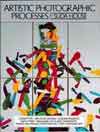Problems in washing out Inkodye light-activated dye
Problems in washing out Inkodye light-activated dye
Name: Jessica
—ADVERTISEMENT—
Instructions for
using Inkdoyes

by Suda House
More books about photos on fabric
Country or region: USA
Message: I am using Inkodye to make photographic prints on cotton and leather using contact printing via negatives and I am having a problem with the 'washing out'.
I cannot get the 'unexposed' areas of the print to effectively 'wash out' - they keep 'developing' and thus my beautiful photographic print disappears over time. I understand that boiling water should help, but I'm wondering if there is some chemical that I could apply to the print that would effectively 'stop' the reaction, 'stop' the oxidation of the leuco vat dye so that my print stays looking great!
I'm trying to complete a project very dear to my heart, please help me find a solution. Thank you very much!
I'm trying to complete a project very dear to my heart, please help me find a solution. Thank you very much!
Are you using cold running water for your developing stage, changing the water very frequently? And are you then following this with warm soapy water?
The best book for instructions in using Inkodyes is Suda House's book, Artistic Photographic Processes. She goes into far more detail, useful detail, than any other source I've seen. After applying the dye to the surface, letting it dry, and exposing it with the masks to an ultraviolet light source, she says,
"7. Before development in ordinary room light, prepare two trays, one for cold running water and the other filled with warm, soapy water. (Suggestion: Dilute 1 tablespoon [15 ml] of liquid soap in 1000 cc [one liter] tap water.) Develop by immersing the fabric in the tray of cold running water for 5 minutes. The dye from the unexposed areas will stain your hands, so rubber gloves are advisable. Change the water in the tray every minute, so that excess dyes run off and do not contaminate highlight or unexposed areas. Next, place the fabric in the tray of warm, soapy water, continuously agitating the tray for 5 minutes.
"8. The fabric may be vigorously rubbed in the soapy water; this is sometimes necessary to clear the highlights from possible staining or overexposure. Some photographers actually develop large fabric pieces in the washing machine, first in a 10-minute agitation cycle without soap and then in a cycle with soap added. Complete with two rinse cycles
"9. At this point, if the dyes are still running, repeat step 8 until no more dye colors the water. Development is now complete."
"8. The fabric may be vigorously rubbed in the soapy water; this is sometimes necessary to clear the highlights from possible staining or overexposure. Some photographers actually develop large fabric pieces in the washing machine, first in a 10-minute agitation cycle without soap and then in a cycle with soap added. Complete with two rinse cycles
"9. At this point, if the dyes are still running, repeat step 8 until no more dye colors the water. Development is now complete."
Following those steps, the image is to be allowed to dry flat on blotter paper, and then ironed at the cotton setting on the wrong side, in order to complete the permanent setting of the dyes. Other sources recommend baking, instead of ironing.
The cold running water development may be performed under ordinary room light, she says, but the preceding steps are done under a yellow safe light, one which presumably emits no ultraviolet light. You're probably being careful not to use room light that emits a large amount of ultraviolet during the washing-out process, but if not, that's another thing to consider. (I believe that fluorescent lights emit more ultraviolet than incandescent lights do.)
The Inkodye information on my site is found in two places: "About Vat Dyes" and "How to Dye and Paint Fabric with Light". Neither of these pages goes into nearly the same detail as Artistic Photographic Processes. The book is out of print, having been published in 1985, but used copies are readily available for only a few dollars.
(Please help support this web site. Thank you.)
(Please help support this web site. Thank you.)
Posted: Friday - February 11, 2011 at 08:23 AM
Follow this blog on twitter here.
Quick Links
- All About Dyes & Dyeing Top -
- Top of this blog -
- FAQ -
- The Dye Forum -
- How to Tie Dye - How to Batik -
- Books - Toys - Plants -
- Top of this blog -
- FAQ -
- The Dye Forum -
- How to Tie Dye - How to Batik -
- Books - Toys - Plants -
More in this category:
- -
Statistics
Total entries in this blog:
Total entries in this category:
Published On: Aug 29, 2012 02:49 PM
Total entries in this category:
Published On: Aug 29, 2012 02:49 PM